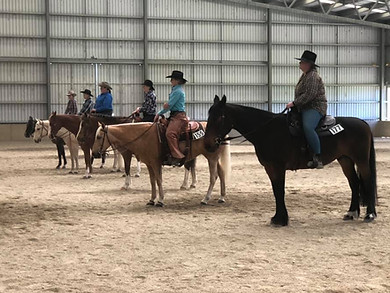About the Club
The Club objectives are:
-
to encourage friendship through horsemanship;
-
to promote western riding;
-
to develop an interest in western horsemanship; and
-
to project a positive image of the western rider.

The Club runs three shows per year in November, January and March.
Also running training and club days in the winter.
Our events are usually held at the
Telford Equine Unit, Gray Road
(off Owaka Highway), Balclutha.
We have also held some training at the
Otago Equestrian Centre at 179 Dukes Road North, Mosgiel.
The Club is affiliated to the New Zealand Western Riding Federation and is governed by the Federation’s rules and regulations.
The Club also follows the rules of the American Quarter Horse Association.
Introducing Western Riding



Halter
-
Horses are judged on conformation and type according to breed requirements.
-
They are shown with a leather halter and are walked and trotted before the judge.
-
Halter classes are divided by the horses age and sex. Horses are judged on balance, structural correctness, breed and sex characteristics and degree of muscling, but balance is the most important.
Horsemanship
-
In this event the rider is judged, but the performance of the horse comes into contention. Contestants exhibit their ability to ride and control a horse to a pattern set by the judge. This must include walk, jog, lope, stop and back up.
-
Follow the pattern then ride as a group around the ring through all paces as directed.
Western Reining
-
An individual event performed using one of the 12 patterns in the NZWRF rule book and consists of mostly loping with controlled speed, demonstraining circles, variation in speed, flying lead changes, roll backs and spins.
-
Judging the horse on its mastery of manoeuvres. The horse should be willing to be guided with little or no resistance.
English Equitation
-
This event is similar to horsemanship, but in English attire with English rules of equitation.
-
Complete a pattern individually then ride around the ring all together. Pattern includes changing gaits; backing up, and posting on correct diagonal and counter-cantering.
-
Tests the rider’s ability to ride, not the performance of the horse. Emphasis is placed on the ability to sit correctly, hold the correct riding posture and control the horse on a precise pattern.
Showmanship
at Halter
-
This class is judged on the competitor exhibiting the best ability to show a horse in a halter with precision and safety (without touching it).
-
Lead your horse in a set pattern designed by the judge including walk, jog, stops, turns and back up, Performed individually and then line up in the ring all together.
-
The judge evaluates the preciseness of the pattern, degree of confidence, grooming and halter fit, and the expertise of the competitor in presenting the horse to look its best.
Western Trail
-
Horses are judged on their ability to negotiate obstacles in a specified order and gait. These can include opening, riding through and closing a gate, going over a bridge, walking, jogging or loping over poles or around cones, side passing, and backing through obstacles.
-
This is an individual event. The judge evaluates the horse’s willingness, ease and grace through the course.
Western Riding
-
An individual riding event using a set pattern at specified gaits. Horses are judged on the qualities of each gait, flying changes of lead, response to the rider, manners, disposition and intelligence. This event requires a high degree of training for the horse. It involves a number of flying changes of lead at a controlled pace. This event is one of the most challenging of the western events.
Western Pleasure
-
The horse is judged on performance , manners, conformation, quality and substance. Horses are shown at the walk, jog , lope and are required to rein back. The winning Western Pleasure Horse is a pleasure to ride, calm and quiet, performing with smooth transitions without visible commands on a reasonably loose rein.
-
Ride as a group around the ring through all paces as directed.
Ranch Riding
-
An individual patterned event designed to showcase the movement and versatility of ranch style horses. The pattern will consist of specified gaits, manoeuvres and changes of rein.
-
Horse and rider are scored on cadence and rhythm of gaits, smoothness and consistency of performance and how well the manoeuvres are completed, including the horse's ability to work in a forward manner with the versatility, attitude and movement of a working horse.
-
If a horse enters this class it cannot be entered into any Western Pleasure class.
Hunter under Saddle
-
A class similar to Western Pleasure, performied in English attire.
-
Evaluates the horse on the flat, at a walk, trot and canter around the ring all together.
-
Emphasis is placed on smoothness of gait, free-flowing stride and willingness to perform.
Some Class Patterns




















